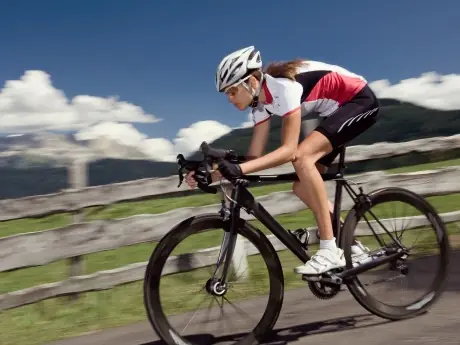Aero Bars
Aside from wheels, one of the easiest ways to purchase speed is by adding a set of "aero" (short for aerodynamic) handlebars to your bicycle. Time trial bikes will use a specialized "base" bar along with aerodynamic extension bars to allow you to ride in a downhill skier-like tuck. For greater versatility, you can opt to add a set of "clip-on" bars that mount on your existing drop handlebar.
These clip-ons act as the extensions to give you the low aerodynamic tuck so helpful for time trials. They are an inexpensive alternative to purchasing a dedicated bike, and while they do add weight, the aerodynamic savings, as measured in time, more than offsets the additional weight. One word of caution: This is not a piece of equipment to be used on group rides; these are most appropriate for time trials and other individual rides.
Carbon Fiber Seatpost
Switching from an aluminum to a carbon fiber seatpost is a relatively inexpensive upgrade, and it can result in more comfort at the saddle, as well, while cutting weight slightly. The real advantage to adding a carbon fiber seatpost is for riders who have a bicycle with an aluminum frame; a carbon fiber seatpost can noticeably cut vibration transmitted to the saddle.

To purchase a seatpost you will need to specify the seatpost diameter (27.2 mm is most common) and length (300 mm and 350 mm are most common). Setback is the distance in millimeters behind the axis of the seat tube that the seatpost clamp lies; this distance varies from manufacturer to manufacturer, though 20 mm is fairly common. Some manufacturers offer seatposts with varying amounts of setback, ranging from as little as none to as much as 35 mm.
Aftermarket Crank Sets
Crank sets made from carbon fiber have become quite popular. Under the right circumstances, a carbon fiber crankset has the potential to be lighter than an aluminum crank set, as well as stiffer and stronger. Achieving this has been another matter. Shimano continues to make its top-of-the-line Dura-Ace crank set from aluminum because the company has not been entirely satisfied with the results from its testing of carbon fiber cranks.
Most riders purchasing carbon fiber cranks are doing so for reasons of weight loss. The fact is, most carbon fiber crank sets are only marginally lighter than their top-of-the-line aluminum counterparts, while the aluminum crankset are usually stiffer, as well.
More: Get your crankset moving with a new pair of cycling shoes.
Carbon Fiber Fork
It used to be that upgrading a bicycle's fork to carbon was a popular way to gain some comfort and reduce weight. Most road bikes today are designed with a specific fork in mind that's meant to ensure a harmonious appearance and optimal handling. Replacing your bicycle's fork with a new aftermarket fork can cut weight while increasing upper-body comfort, thanks to vibration damping. Any change should be undertaken with some caution.
Changing a fork for one with less fork rake will slow the bicycle's handling, making it more resistant to turning. Conversely, changing to a fork with more fork rake will speed the bicycle's handling, making it more responsive to steering input. Also, different forks will have a different axle-to-crown distance. If that distance is reduced, the bicycle's head tube rotates down (relative to the rear axle), thereby increasing the head tube angle and making the bike handle more quickly. A longer axle-to-crown distance will decrease the head-tube angle and make the bike more resistant to turning.
To purchase a fork you will need to specify the steerer diameter (1 1/8-in. is most common) and the rake (usually 40, 43, or 45 mm).
- 2
- of
- 2
About the Author










Discuss This Article